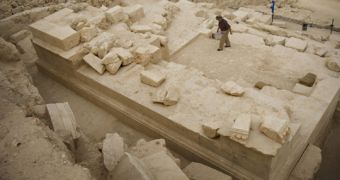The group of Israeli archaeologists that are in charge of investigating the remains of King Herod's winter palace at Herodium believe they have found enough preliminary evidence in order to assume that this was his actual burial place. The walls of crypt found within a two story mausoleum are covered by lavish Roman style paintings, suitable for a king and unprecedentedly seen in the Middle East.
King Herod (73 BC - 4 BC) was thought to be a puppet ruler for the Romans and hated as such, as well as for his supposed ruthlessness and megalomania. One of the tombs in the mausoleum has been discovered to bear marks of extreme devastation and violent behavior, which led the scientists to conclude that those who performed such deeds at the time knew that it held the king's remains. "That sarcophagus was found shattered all over the place. It seems it was taken from its place and was destroyed in a fit of rage," explained archaeologist Roi Porat for the Associated Press, as cited by LiveScience. "That, among other things, is what tells us it was the sarcophagus of Herod."
As to their discovery, Ehud Netzer, chief of the excavation team from the Hebrew University in Jerusalem, explained that "What we found here, spread all around, are architectural fragments that enable us to restore a monument of 25 meters high, 75 feet high, very elegant, which fits Herod's taste and status". The palace is built on a 2,230-foot (680-meter) high hill, partly human made, and comprises baths, a pool, gardens, aqueducts (in a place lacking water, which was brought from afar at very high costs) and a theater with 650 seats.
According to Rachel Chachy-Laureys, the surveyor of the site, the paintings were likely made by Roman artists, "There has been no other discovery of this type of painting in the Middle East, as far as we know, until now". Still, no actual human remains or specific inscriptions related to the king's burial in this specific place have been found, so there's no absolute certainty on the matter just yet. But the researchers hope their future digging will eventually provide that kind of clues as well.

 14 DAY TRIAL //
14 DAY TRIAL //